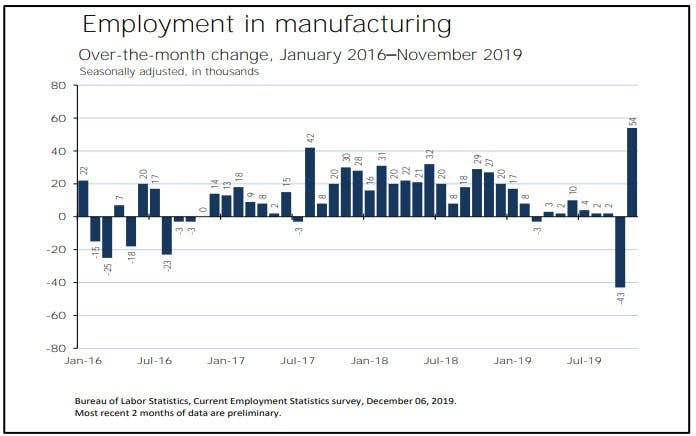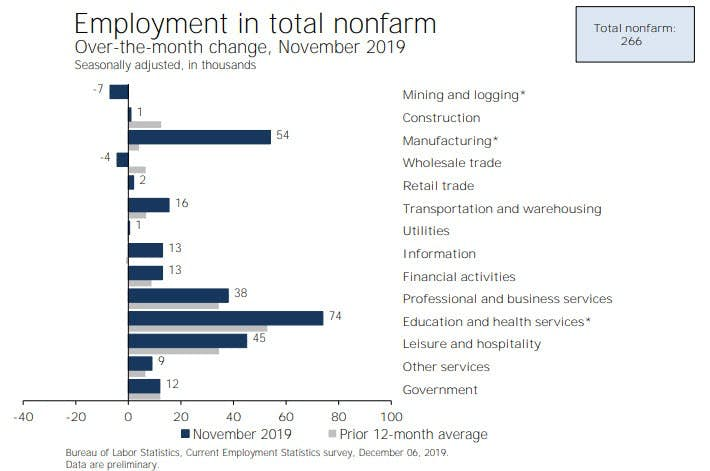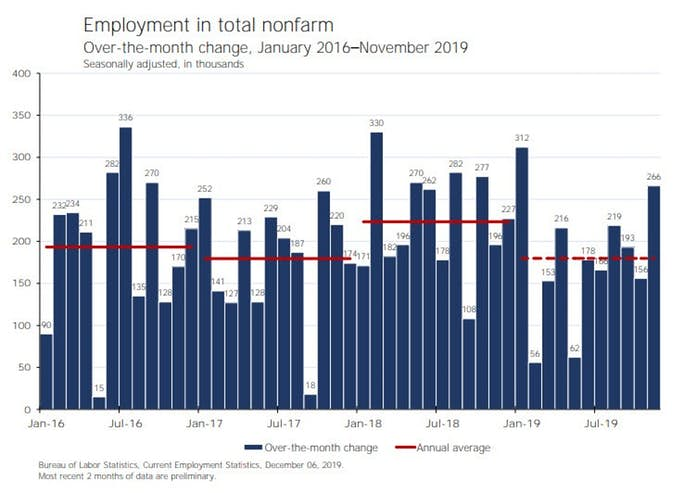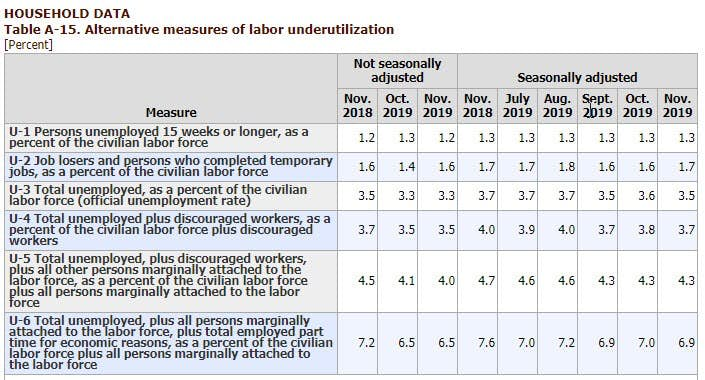
Jobs rose far more than expected in a rebound from GM strike end and seasonal adjustment factors.
Initial Reaction
Jobs came in much better than expected. ADP forecast a mere 67,000 jobs.
The GM strike ended and that explains a huge surge in manufacturing and auto parts jobs.
Seasonal factors also skewed the report. Thanksgiving was very late in the month, in fact, on the last possible day, November 28.
Auto Parts Jobs

Job Revisions
The change in total nonfarm payroll employment for September was revised up by 13,000 from +180,000 to +193,000, and the change for October was revised up by 28,000 from +128,000 to +156,000. With these revisions, employment gains in September and October combined were 41,000 more than previously reported. After revisions, job gains have averaged 205,000 over the last 3 months.
Also recall my August 21 report: BLS Revises Payrolls 501,000 Lower Through March.
Those revisions are not reflected in the charts. The newer revisions are.
BLS Jobs Statistics at a Glance
- Nonfarm Payroll: +266,000 - Establishment Survey
- Private Nonfarm Payroll: +254,000 - Establishment Survey
- Employment: +83,000 - Household Survey
- Unemployment: -44,000 - Household Survey
- Involuntary Part-Time Work: -15,000 - Household Survey
- Voluntary Part-Time Work:-24,000 - Household Survey
- Baseline Unemployment Rate: -0.1 to 3.5% - Household Survey
- U-6 unemployment: -0.1 to 6.9% - Household Survey
- Civilian Non-institutional Population: +175,000
- Civilian Labor Force: +40,000 - Household Survey
- Not in Labor Force: +135,000 - Household Survey
- Participation Rate: -0.1 to 63.2% - Household Survey
BLS Employment Report Statement
"Total nonfarm payroll employment rose by 266,000 in November, and the unemployment rate was little changed at 3.5 percent, the U.S. Bureau of Labor Statistics reported today. Notable job gains occurred in health care and in professional and technical services. Employment rose in manufacturing, reflecting the return of workers from a strike."
Unemployment Rate – Seasonally Adjusted
The above Unemployment Rate Chart is from the BLS. Click on the link for an interactive chart.

Nonfarm Employment Change from Previous Month by Job Type

Nonfarm Employment Change from Previous Month Trends

Hours and Wages
Average weekly hours of all private employees were steady at 34.4 hours. Average weekly hours of all private service-providing were steady at 33.2 hours. Average weekly hours of manufacturers was rose 0.1 hours to 40.5 hours.
Average Hourly Earnings of All Nonfarm Workers rose $0.07 to $28.29.That's a gain of 0.25%.
Average hourly earnings of Production and Supervisory Workers rose $0.07 to $23.83. That's a 0.29% gain.
Year-Over-Year Wage Growth
- All Private Nonfarm rose from $27.43 to $28.29, a gain of 3.1%.
- All production and supervisory rose from $22.99 to $23.83, a gain of 3.7%.
For a discussion of income distribution, please see What’s “Really” Behind Gross Inequalities In Income Distribution?
Birth Death Model
Starting January 2014, I dropped the Birth/Death Model charts from this report. For those who follow the numbers, I retain this caution: Do not subtract the reported Birth-Death number from the reported headline number. That approach is statistically invalid. Should anything interesting arise in the Birth/Death numbers, I will comment further.
Table 15 BLS Alternative Measures of Unemployment

Table A-15 is where one can find a better approximation of what the unemployment rate really is.
Notice I said “better” approximation not to be confused with “good” approximation.
The official unemployment rate is 3.5%. However, if you start counting all the people who want a job but gave up, all the people with part-time jobs that want a full-time job, all the people who dropped off the unemployment rolls because their unemployment benefits ran out, etc., you get a closer picture of what the unemployment rate is. That number is in the last row labeled U-6.
U-6 is much higher at 6.9%. Both numbers would be way higher still, were it not for millions dropping out of the labor force over the past few years.
Some of those dropping out of the labor force retired because they wanted to retire. The rest is disability fraud, forced retirement, discouraged workers, and kids moving back home because they cannot find a job.
Strength is Relative
It’s important to put the jobs numbers into proper perspective.
In the household survey, if you work as little as 1 hour a week, even selling trinkets on eBay, you are considered employed.
In the household survey, if you work three part-time jobs, 12 hours each, the BLS considers you a full-time employee.
In the payroll survey, three part-time jobs count as three jobs. The BLS attempts to factor this in, but they do not weed out duplicate Social Security numbers. The potential for double-counting jobs in the payroll survey is large.
Household Survey vs. Payroll Survey
The payroll survey (sometimes called the establishment survey) is the headline jobs number, generally released the first Friday of every month. It is based on employer reporting.
The household survey is a phone survey conducted by the BLS. It measures unemployment and many other factors.
If you work one hour, you are employed. If you don’t have a job and fail to look for one, you are not considered unemployed, rather, you drop out of the labor force.
Looking for jobs on Monster does not count as “looking for a job”. You need an actual interview or send out a resume.
These distortions artificially lower the unemployment rate, artificially boost full-time employment, and artificially increase the payroll jobs report every month.
Final Thoughts
Last month I commented "Looking ahead, the GM strike is over."
This month we can say the end of the GM strike provided a one month or perhaps 2-month lift in jobs. Next month will tell.
Seasonal adjustments on top of GM further skewed things.
This was a good report but not as good as it looked. The household survey only reported a gain of 83,000 jobs.
This material is based upon information that Sitka Pacific Capital Management considers reliable and endeavors to keep current, Sitka Pacific Capital Management does not assure that this material is accurate, current or complete, and it should not be relied upon as such.
Recommended Content
Editors’ Picks
USD/JPY holds above 155.50 ahead of BoJ policy announcement

USD/JPY is trading tightly above 155.50, off multi-year highs ahead of the BoJ policy announcement. The Yen draws support from higher Japanese bond yields even as the Tokyo CPI inflation cooled more than expected.
AUD/USD extends gains toward 0.6550 after Australian PPI data

AUD/USD is extending gains toward 0.6550 in Asian trading on Friday. The pair capitalizes on an annual increase in Australian PPI data. Meanwhile, a softer US Dollar and improving market mood also underpin the Aussie ahead of the US PCE inflation data.
Gold price keeps its range around $2,330, awaits US PCE data

Gold price is consolidating Thursday's rebound early Friday. Gold price jumped after US GDP figures for the first quarter of 2024 missed estimates, increasing speculation that the Fed could lower borrowing costs. Focus shifts to US PCE inflation on Friday.
Stripe looks to bring back crypto payments as stablecoin market cap hits all-time high

Stripe announced on Thursday that it would add support for USDC stablecoin, as the stablecoin market exploded in March, according to reports by Cryptocompare.
Bank of Japan expected to keep interest rates on hold after landmark hike

The Bank of Japan is set to leave its short-term rate target unchanged in the range between 0% and 0.1% on Friday, following the conclusion of its two-day monetary policy review meeting for April. The BoJ will announce its decision on Friday at around 3:00 GMT.